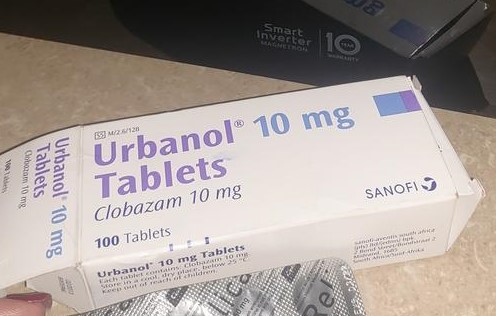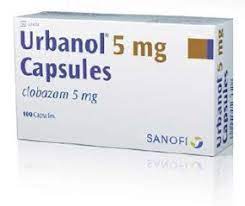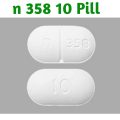What Is Urbanol Used For?
Urbanol is a medication that contains clobazam as its active ingredient. Clobazam is classified as a benzodiazepine, which is a type of medication that acts on the central nervous system to produce a calming effect. Urbanol is primarily used to treat various conditions, including:
- Epilepsy: Urbanol is prescribed as an adjunctive treatment for certain types of seizures associated with epilepsy, such as Lennox-Gastaut syndrome. It helps to reduce the frequency and severity of seizures.
- Anxiety Disorders: Urbanol is sometimes prescribed for the short-term management of anxiety disorders, such as generalized anxiety disorder. It can help alleviate symptoms of excessive worry, restlessness, and tension.
- Muscle Spasms: Urbanol may be used to relieve muscle spasms caused by conditions like cerebral palsy or certain neurological disorders.
Urbanol should be used under the guidance and prescription of a qualified healthcare professional. It is important to follow the prescribed dosage and duration of treatment, as benzodiazepines can be habit-forming and may lead to dependence if misused or taken for extended periods. Additionally, abrupt discontinuation of Urbanol should be avoided, as it may result in withdrawal symptoms.
Urbanol is available in two different strengths: 5 mg capsules and 10 mg tablets. The 5 mg capsules contain 5 milligrams of clobazam as the active ingredient, while the 10 mg tablets contain 10 milligrams of clobazam.
The choice between capsules and tablets may depend on individual preferences, as well as the prescribing physician’s recommendations. Some people may find it easier to swallow tablets, while others prefer capsules. The decision may also be influenced by the specific dosage required for the prescribed treatment.
How to take Urbanol
The dosage of Urbanol can vary depending on the specific condition being treated, individual patient factors, and the prescribing physician’s recommendations. The typical starting dose and maintenance dose for Urbanol are as follows:
- Epilepsy:
- Adults and adolescents (ages 13 and older): The usual starting dose is 20 to 30 mg per day, divided into two to three doses. This dose may be gradually increased by 5 to 10 mg per week as needed. The maximum recommended daily dose is 60 mg.
- Children (ages 2 to 12): The usual starting dose is 5 to 10 mg per day, divided into two to three doses. This dose may be gradually increased by 5 mg per week as needed. The maximum recommended daily dose is 20 mg.
- Anxiety disorders:
- Adults: The typical starting dose is 10 mg per day, divided into two doses. This dose may be adjusted as needed based on individual response and tolerability, usually not exceeding 30 mg per day.
It’s important to note that these are general dosage guidelines, and individual dosing may vary. The dosage should always be determined by a healthcare professional based on a thorough evaluation of your medical history, condition, and response to treatment. It’s crucial to follow your doctor’s instructions and never adjust the dosage on your own without consulting them.
Is Urbanol an addictive medication?
Yes, Urbanol and other benzodiazepines are known to be addictive. Even when taken as prescribed by a healthcare professional, these medications can lead to dependence and addiction. Benzodiazepine withdrawal syndrome, often referred to as “tranquilizer addiction,” can occur when a person becomes physically dependent on the drug. Neurons in the brain adapt to the presence of clobazam and become underactive when the medication is withdrawn, resulting in withdrawal reactions.
The withdrawal effects of longer-acting benzodiazepines like Urbanol can be most pronounced within a month or two, while shorter-acting medications can lead to withdrawal effects within a week of daily use. Precautions and contraindications for Urbanol are similar to those for other benzodiazepines, as they can cause physical dependence due to the changes they induce in brain chemistry and function.
Prescription drug addiction, including benzodiazepine addiction, is a rapidly growing issue worldwide. While these medications provide relief for the medical conditions they are prescribed for, they also carry the risk of addiction. Symptoms of addiction are often associated with compulsive or uncontrolled drug use beyond the prescribed parameters. Substance use disorders are typically characterized by continued substance use despite negative effects on health and well-being.
It is important to use Urbanol or any benzodiazepine strictly as prescribed and under the guidance of a healthcare professional to minimize the risk of addiction and withdrawal symptoms. If you have concerns about addiction or dependency, it is advisable to discuss them with your doctor. They can provide guidance on appropriate use, potential alternatives, and strategies for managing your condition.
How long does Urbanol stay in your system?
Urbanol has a half-life elimination time of approximately 16 hours in children, while in adults, it can range from 36 to 42 hours. Additionally, there is a metabolite of Urbanol that remains in the body for up to 82 hours. Urbanol is considered a long-acting medication, which means withdrawal symptoms may onset later compared to drugs with shorter half-lives. Users may begin experiencing withdrawal symptoms anywhere from 24 to 48 hours after discontinuing usage, and sometimes even longer. Due to its prolonged action, Urbanol can also be detected in drug tests for an extended period of time.
Side Effects Of Urbanol
Urbanol can have various side effects. It’s important to note that not all side effects are listed in the provided leaflet, so it’s recommended to consult a healthcare professional if your general health worsens while taking Urbanol. However, there are some serious side effects that require immediate medical attention:
- Allergic reactions:
- Swelling of the hands, feet, ankles, face, lips, mouth, or throat, makes it difficult to swallow or breathe.
- Rash or itching.
- Fainting.
If any of these serious side effects occur, stop taking Urbanol and seek medical attention promptly.
Other serious side effects that require immediate medical attention include:
- Restlessness, difficulty sleeping, or nightmares.
- Irritability or anxiety.
- Delusions (believing things that are not true) or hallucinations (sensing things that are not there).
- Suicidal feelings.
These side effects are more likely to occur in elderly individuals and children.
There are also common side effects that may not be as serious but still require attention:
- Sleepiness or dizziness.
- Dry mouth and constipation.
- Loss of appetite, nausea, or vomiting.
- Shaking fingers.
Other less common side effects may include:
- Difficulty staying awake or alert.
- Slowed reactions.
- Memory loss or confusion.
- Headaches.
- Muscle weakness.
- Problems with walking or other movements.
- Loss of sexual drive.
- Aggression.
- Mood depression.
- Dependency on Urbanol (physical or mental dependence).
- Eye problems such as double vision.
- Breathing problems.
- Liver problems.
- Skin rashes or hives.
- Rare severe skin conditions like Stevens-Johnson syndrome or toxic epidermal necrolysis.
- Weight gain.
- Increased risk of falling in the elderly.
- Blood dyscrasias (abnormal bleeding or bruising, nosebleeds, pale appearance, fever, severe chills, sore throat, or mouth ulcers).
If you experience any side effects not mentioned in the leaflet, it’s important to inform your doctor, pharmacist, or healthcare professional.
Interactions
Urbanol can interact with various medications, substances, and medical conditions. It’s important to inform your doctor or pharmacist about all the medications you are currently taking, including prescription drugs, over-the-counter medications, herbal supplements, and recreational substances. Here are some notable drug interactions with Urbanol:
- Central Nervous System Depressants: Urbanol can enhance the sedative effects of other central nervous system depressants, such as alcohol, opioids (e.g., codeine, morphine), barbiturates, sedatives, and other benzodiazepines. Combining these substances can increase the risk of excessive sedation, respiratory depression, and even coma. It is crucial to use these substances cautiously and under medical supervision.
- Antiepileptic Drugs (AEDs): Urbanol may interact with other AEDs, such as phenytoin, phenobarbital, carbamazepine, and valproate. These interactions can affect the blood levels and effectiveness of both Urbanol and the other AEDs. Dose adjustments may be necessary to maintain therapeutic levels.
- CYP2C19 and CYP3A4 Inducers and Inhibitors: Urbanol is metabolized by the liver enzymes CYP2C19 and CYP3A4. Drugs that induce or inhibit these enzymes can impact the metabolism and blood levels of Urbanol. Examples include rifampicin, cimetidine, fluoxetine, fluvoxamine, omeprazole, and certain antifungal medications. Dose adjustments may be required when Urbanol is used concomitantly with these drugs.
- Grapefruit Juice: Grapefruit juice can inhibit the activity of CYP3A4 enzymes, which may increase the blood levels of Urbanol. It is generally advised to avoid consuming grapefruit or grapefruit juice while taking Urbanol.
- Respiratory Conditions: Urbanol may cause respiratory depression, especially when combined with other medications that can suppress breathing. Use caution when taking Urbanol if you have a history of respiratory conditions, such as chronic obstructive pulmonary disease (COPD), asthma, or sleep apnea.
- Renal Impairment: Urbanol is eliminated from the body through the kidneys. In individuals with impaired renal function, the clearance of Urbanol may be reduced, leading to higher blood levels. Dose adjustments may be necessary in patients with renal impairment.
It’s important to note that this is not an exhaustive list of drug interactions. Always consult your healthcare provider or pharmacist for a comprehensive review of your medications and potential interactions before starting or stopping any medication.
Can I mix Urbanol with alcohol?
No, it is not recommended to mix Urbanol with alcohol. Both Urbanol and alcohol are central nervous system depressants, which means they can slow down brain activity and lead to drowsiness, impaired coordination, and reduced reaction times. When taken together, the depressant effects of Urbanol and alcohol can be significantly intensified and pose serious risks.
Combining Urbanol and alcohol can increase the likelihood of experiencing excessive sedation, respiratory depression, and loss of consciousness. These effects can be dangerous and potentially lead to accidents, injuries, or even overdose. Benzodiazepines like Urbanol rarely cause overdoses on their own, but when combined with alcohol, the risk of respiratory issues and other severe complications becomes more significant, and it can even be life-threatening.
Furthermore, mixing alcohol with Urbanol may interfere with the therapeutic effects of the medication in the treatment of anxiety and depression. Alcohol itself can worsen these conditions and may hinder the psychological treatment process.
It is essential to follow the guidance of your healthcare provider and avoid consuming alcohol while taking Urbanol or any other benzodiazepine medication. If you have any concerns or questions about combining medications or substances, it is best to consult with your doctor or pharmacist for personalized advice.






